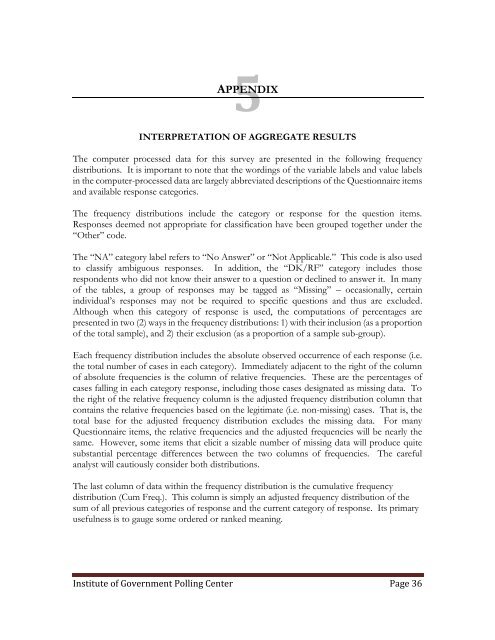JSU Spring 2015 Report
Create successful ePaper yourself
Turn your PDF publications into a flip-book with our unique Google optimized e-Paper software.
5<br />
APPENDIX<br />
INTERPRETATION OF AGGREGATE RESULTS<br />
The computer processed data for this survey are presented in the following frequency<br />
distributions. It is important to note that the wordings of the variable labels and value labels<br />
in the computer-processed data are largely abbreviated descriptions of the Questionnaire items<br />
and available response categories.<br />
The frequency distributions include the category or response for the question items.<br />
Responses deemed not appropriate for classification have been grouped together under the<br />
“Other” code.<br />
The “NA” category label refers to “No Answer” or “Not Applicable.” This code is also used<br />
to classify ambiguous responses. In addition, the “DK/RF” category includes those<br />
respondents who did not know their answer to a question or declined to answer it. In many<br />
of the tables, a group of responses may be tagged as “Missing” – occasionally, certain<br />
individual’s responses may not be required to specific questions and thus are excluded.<br />
Although when this category of response is used, the computations of percentages are<br />
presented in two (2) ways in the frequency distributions: 1) with their inclusion (as a proportion<br />
of the total sample), and 2) their exclusion (as a proportion of a sample sub-group).<br />
Each frequency distribution includes the absolute observed occurrence of each response (i.e.<br />
the total number of cases in each category). Immediately adjacent to the right of the column<br />
of absolute frequencies is the column of relative frequencies. These are the percentages of<br />
cases falling in each category response, including those cases designated as missing data. To<br />
the right of the relative frequency column is the adjusted frequency distribution column that<br />
contains the relative frequencies based on the legitimate (i.e. non-missing) cases. That is, the<br />
total base for the adjusted frequency distribution excludes the missing data. For many<br />
Questionnaire items, the relative frequencies and the adjusted frequencies will be nearly the<br />
same. However, some items that elicit a sizable number of missing data will produce quite<br />
substantial percentage differences between the two columns of frequencies. The careful<br />
analyst will cautiously consider both distributions.<br />
The last column of data within the frequency distribution is the cumulative frequency<br />
distribution (Cum Freq.). This column is simply an adjusted frequency distribution of the<br />
sum of all previous categories of response and the current category of response. Its primary<br />
usefulness is to gauge some ordered or ranked meaning.<br />
Institute of Government Polling Center Page 36







